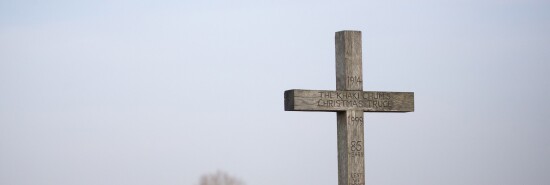
Remember the Christmas truce
Dan A. Nygaard
Video Embed
On Christmas Eve 1914, in battle trenches that stretched from Switzerland to the North Sea, combatants laid down their weapons and ventured into no man’s land. German, British, and French soldiers bet their lives on Christmas, and they won. Men of goodwill spontaneously met to celebrate Christmas, reminding themselves that peace was not impossible.
Live and let live accommodations have occurred in many wars. No other occurred with the scale, duration, or potential as the Christmas truce of December 1914.
Historians relegate the Christmas truce during World War I to very few and very localized, fleeting ceasefires. The governments of Germany, England, and France suppressed that truce nearly as voraciously as China’s Communist Party suppressed the Tiananmen Square protests. As a result, the Christmas truce appears unreal and incredible — a fantasy.
Dismissed in official histories as an aberration of no consequence, that remarkable Christmas truce did happen. Generals feared World War I might come to a screeching halt. Europe’s nascent military-industrial complex employed coercion and propaganda to keep the war going. In March 1930, in the British House of Commons, WWI Maj. H. Kingsley Wood recounted his participation in the truce. That member of Parliament claimed that if the soldiers had been left to themselves, there would not have been another shot fired after Christmas.
Twenty-first century historians struggle to identify what drove WWI to continue another four years, consume millions of lives, and destroy empires. In his 2001 book Silent Night, Stanley Winetraub unearthed letters to the editor published in hundreds of local German, English, and French newspapers from men in uniform who reported their personal accounts of soldiers celebrating the Christmas together, and of the combatants questioning what they were fighting for.
Although celebrated by the rank and file as a respite and opportunity to retreat from war, the truce dismayed ruling elites. For the rival governments, invested in war as politics by coercive force, it was imperative to make any ceasefire unappealing and unworkable. The Christmas truce was a threat to the ruling classes; if soldiers ceased fighting each other, they might redirect their energy into the kind of spontaneous movements that topple governments.
After a silent night plus a day — although, in many sectors, the truce lasted a week — orders and threats induced soldiers to resume the war demanded by their governments. Generals even made plans to subvert future truces. The extent of the Christmas truce was actively suppressed and has subsequently faded from history. Most of the letter writers were eventually consumed by the war, their voices silenced, their questions unanswered.
In December 1999, nine quirky reenactors commemorated the Christmas truce near Pledgedeer Wood in Belgium. Wearing makeshift WWI uniforms and laboring in rain and snow, they dug trenches, built parapets, cooked rations, and got soaked to the skin. They hosted curious onlookers and were occasionally interviewed by local media.
CLICK HERE TO READ MORE FROM THE WASHINGTON EXAMINER
The reenactors’ final act was to erect a large timber cross out of respect to the unsophisticated soldiers of WWI who celebrated a Christmas truce and might have stopped the war. Months later, the nine reenactors were surprised to learn that locals had treated their crude memorial with wood preservative and set it in a concrete base. Around the base of the cross was planted a field of poppies that flourished that spring.
Across Europe, governments have erected hundreds of memorials to the First World War. But no government has recognized the Christmas truce. The only memorial to peace is an old rugged cross erected by a handful of reenactors, preserved by locals, surrounded by poppies. Apt symbols of the human longing for peace and goodwill.
Dan Nygaard pastors Hope Community Fellowship in Fort Collins, Colorado, and is the author of Star Readers from Out of the East.
